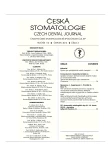The Benefit of E-learning in Classical Full-time Teaching of Dentistry
Authors:
Ľ. Harvan; J. Stejskalová
Authors‘ workplace:
Klinika zubního lékařství LF UP a FN, Olomouc
Published in:
Česká stomatologie / Praktické zubní lékařství, ročník 112, 2012, 3, s. 46-55
Category:
Original Article – Analytical Study
Overview
Introduction:
Both information and communication technologies are firmly established in many areas of modern life. In this regard, dentistry is not an exception. Nowadays we use them from the first moment of the patient’s visit at the dentist’s office. Besides diagnosis and treatment, the information and communication technologies can be applied in dentistry students’ teaching process. It comprises e-learning training which presently becomes very popular in universities’ teaching process. The using of modern information and communication technologies in classical education creates a new style that seems to be very beneficial for the dentistry teaching.
Aims:
The work aims at assessing the benefits of original e-course application in dentistry full-time teaching according to students’ opinions.
Methods:
The survey was launched in the academic year 2010/2011. The research involved 419 students of all dentistry courses at the Medical Faculty of Palacky University in Olomouc. The students’ opinion regarding application of e-learning elements in the dentistry classical teaching has been investigated by questionnaires. Questionnaires included two types of questions: closed (structured) and open (unstructured).
Another type of questionnaire was used to determine students’ opinions on the e-course created. This anonymous online questionnaire is placed in E-learning section on Dentistry Clinic website, Palacky University, Olomouc. The results received were processed statistically by using χ2 test.
Results:
The total return of the questionnaires was 87.77%. The term “e-learning” was clear to 333 students (89.76%). Most respondents (84.91%) considered the use of e-learning in dentistry teaching as beneficial. The results are both clearly positive and statistically significant.
Conclusions:
The results of our research proved students’ positive attitude to the introduction of e-learning elements into the traditional teaching of dentistry. The vast majority of students welcome the further development of e-course.
Key words:
information and communication technologies – e-learning – blended learning – e-course – full-time teaching – questionnaires – dentistry students
Sources
1. Eaton, K. A., Reynolds, P. A., Grayden, S. K., Wilson, N. H. F.: A vision of dental education in the third millenium. Br. Dent. J., roč. 205, 2008, č. 5, s. 261–271.
2. El Tantawi, M. M. A.: Evaluation of a blog used in a dental terminology course for first-year dental students. J. Dent. Educ., roč. 72, 2008, č. 6, s. 725–735.
3. Feeney, L., Reynolds, P. A., Eaton, K. A., Harper, J.: A description of the new technologies used in transforming dental education. Br. Dent. J., roč. 204, 2008, č. 1, s. 19–28.
4. Gormley, G. J., Collins, K., Boohan, M., Bickle, I. C, Stevenson, M.: Is there a place for e-learning in clinical skills? A survey of undergraduate medical students´ experiences and attitudes. Med. Teach., roč. 31, 2009, č. 1, s. e6–12.
5. Gupta, B., White, D. A., Walmsley, A. D.: The attitudes of undergraduate students and staff to the use of electronic learning. Br. Dent. J., roč. 196, 2004, č. 8, s. 487–492.
6. Hillenburg, K. L., Cederberg, R. A., Gray, S. A., Hurst, C. L., Johnson, G. K., Potter, B. J.: E-learning and the future of dental education: opinions of administrators and information technology specialists. Eur. J. Dent. Educ., roč. 10, 2006, č. 3, s. 169–177.
7. Jham, B. C., Duraes, G. V., et al.: Joining the podcast revolution. J. Dent. Educ., roč. 72, 2008, č. 3, s. 278–281.
8. Kopecký, K.: E-learning (nejen) pro pedagogy. 1. vyd. Olomouc, Hanex, 2006. 29, 130 s. ISBN 8085783509.
9. Kopecký, K.: Modely tzv. blended learningu (Úvod do problematiky) [online]. 2004. [cit. 2011-03-20] Dostupný z WWW: <http://epedagog. upol.cz/eped3.2004/clanek06.pdf>
10. Květoň, K.: Úloha e-learningu na školách. 1. vyd. Ostrava: CIT OU, 2005. 12 s.
11. Mattheos, N., Stefanovic, N., Apse, P., et al.: Potential of information technology in dental education. Eur. J. Dent. Educ., roč. 12, 2008, suplement 1, s. 85–91.
12. McCann, A. L., Schneiderman, E. D., Hinton, R. J.: E-teaching and learning preferences of dental and dental hygiene students. J. Dent. Educ., roč. 74, 2010, č. 1, s. 65–78.
13. Neuhaus, K. W., Schegg, R., Krastl, G., Amato, M., Weiger, R., Walter, C.: Integrated learning in dentistry: baseline data and first evaluation at the Dental School of Basel. Eur. J. Dent. Educ., roč. 12, 2008, č. 3, s. 163–169.
14. Plasschaert, A. J. M., Manogue, M., Lindh, C., McLoughlin, J., Murtomaa, H., Nattestad, A., Sanz, M.: Curriculum content, structure and ECTS for European dental schools. Part II: methods of learning and teaching, assessment procedures and performance criteria. Eur. J. Dent. Educ., roč. 11, 2007, č. 3, s. 125–136.
15. Reynolds, P. A., Rice, S., Uddin, M.: Online learning in dentistry: the changes in undergraduate perceptions and attitudes over a four year period. Br. Dent. J., roč. 203, 2007, č. 7, s. 419–423.
16. Schönwetter, D. J., Reynolds, P. A., Eaton, K. A., de Vries, J.: Online learning in dentistry: an overview of the future direction for dental education. J. Oral Rehabil., roč. 37, 2010, č. 12, s. 927–940.
17. Walmsley, A.D., Lambe, C. S., et al.: Podcasts - an adjunct to the teaching of dentistry. Br. Dent. J., roč. 206, 2009, č. 3, s. 157–160.
18. Yip, H. K., Barnes, I. E.: Information technology in dental education. Br. Dent. J., roč. 187, 1999, č. 6, s. 327–332.
19. http://en.wikipedia.org/wiki/Generation_Y
Labels
Maxillofacial surgery Orthodontics Dental medicineArticle was published in
Czech Dental Journal

2012 Issue 3
- What Effect Can Be Expected from Limosilactobacillus reuteri in Mucositis and Peri-Implantitis?
- The Importance of Limosilactobacillus reuteri in Administration to Diabetics with Gingivitis
Most read in this issue
- Effect of Selected Acidic Foodstuffs and Beverages on Enamel Mechanical Properties of Human Extracted Teeth and their Role in Dental Erosion Origin
- Apical Root Resorption after Orthodontic Treatment
- The Benefit of E-learning in Classical Full-time Teaching of Dentistry
